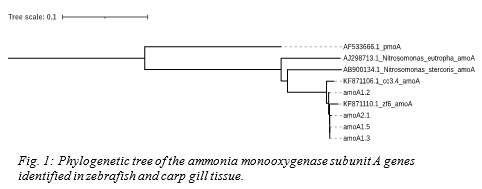GILL-ASSOCIATED NITROGEN CYCLE BACTERIA CONVERT AMMONIA TO NITROGEN GAS IN COMMON CARP Cyprinus carpio AND ZEBRAFISH Danio rerio
Introduction
Ammonia is the main nitrogenous waste produced by teleost fish and its accumulation can lead to toxicity in aquaculture settings where fish are kept at high fish density and are fed protein-rich diets. Controlling ammonia levels is therefore key in recirculating aquaculture systems (RAS). Most ammonia is excreted via the gills of teleost fish, which makes this organ a prime habitat for colonization by nitrogen-cycle bacteria.
Recently, it was shown that excreted ammonia can be converted into dinitrogen gas (N2 ) in carp and zebrafish gills through the combined activity of ammonia-oxidizing and denitrifying bacteria, which interestingly seem to reside inside gill cells of carp
. The role of these bacteria in nitrogenous waste removal by fish is largely unknown . Our project aims to investigate the fundamental characteristics of this novel symbiosis and determine whether it can be used in aquaculture to decrease ammonia excretion of teleost fish. We identified the presence of ammonia-oxidizing bacteria in common carp and zebrafish gills and measured activity of these bacteria in vivo in common carp. We additionally examined 16S rRNA sequencing datasets for presence of nitrogen cycle bacteria in other species than carp and zebrafish.
Materials and methods
Common carp ( Cyprinus carpio) and zebrafish (Danio rerio) were grown under control conditions in recirculating systems with nitrifying biofilters. Fish were euthanized and gills were aseptically removed for microbiome analysis.
The gill microbiome of common carp and zebrafish was investigated through molecular methods. Bacterial DNA was isolated from fish gill and PCRs were performed for the ammonia monooxygenase subunit A gene (a functional marker for ammonia oxidizing bacteria) and nitrite reductase (a functional marker for denitrifying bacteria) . Additionally, 16S rRNA amplicon sequencing was performed to obtain an overview of bacteria present in fish gill samples. We analyzed and compared the results with publicly available 16S rRNA sequencing datasets from teleost fish that included gill samples using the DADA2 pipeline and amplicon sequencing variants (ASVs) of nitrogen cycle bacteria (ammonia oxidizers, nitrite oxidizers and denitrifiers ) were identified using the SILVA database . Phylogenetic relationships were examined, as well as differential abundances of nitrogen cycle bacteria between gill samples and other samples (water, sediment etc.).
Histological analysis was also performed on gills of common carp and zebrafish. Bacteria were localized in gill tissue through fluorescent in situ hybridization and electron microscopy.
Common carp (±50-100g) were used for individual nitrogen gas measurements. Carp were placed in 5L tanks that were closed off from the surrounding air. The atmosphere above the water in the tank was replaced by a mixture of argon and oxygen, after which the accumulation of dinitrogen gas in the headspace was regularly measured with gas chromatography/mass spectrometry for 2.5 hours .
Results
Using on molecular methods, we confirmed the presence of Nitrosomonas-like ammonia oxidizers in carp and zebrafish gills (fig. 1) . Additionally, microscopy indicated that these bacteria seem to be located intracellularly in carp gills.
In our 16S rRNA amplicon sequencing dataset, 2 Nitrosomonadaceae ASVs were found in carp and zebrafish gills. These ASVs were different from the Nitrosomonadaceae species in the water and biofilter. Analysis of other teleost gill microbiomes revealed the presence of 53 Nitrosomonas-affiliated ASVs in gill samples from 6 datasets , indicating that presence of ammonia oxidizers in gills is a widespread phenomenon.
Carp that were kept individually in closed tanks produced measurable amounts of dinitrogen gas within 2.5 hours and the amount of dinitrogen gas produced was higher when these fish were fed (fig. 2). This suggests a correlation between the amount of ammonia produced by fish as a waste product and the resulting production of nitrogen gas by the symbiotic bacteria.
Conclusion
Nitrogen cycle bacteria were present and active in fish gills and present a novel symbiosis between vertebrate animals and bacteria. In future experiments, w e will study how these bacteria are transmitted, as well as the timepoint of colonization of the gills using germ-free zebrafish.
References
van Kessel, M. A., R. J. Mesman, A. Arshad, J. R. Metz, F. T. Spanings, S. C. van Dalen, L. van Niftrik, G. Flik, S. E. Wendelaar Bonga and M. S. Jetten (2016). "Branchial nitrogen cycle symbionts can remove ammonia in fish gills." Environmental microbiology reports 8(5): 590-594.

